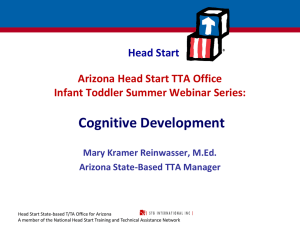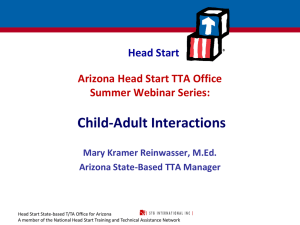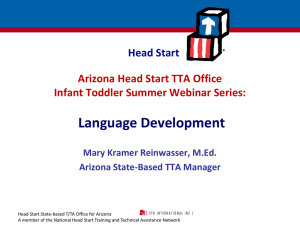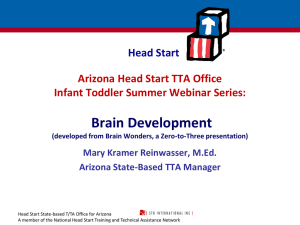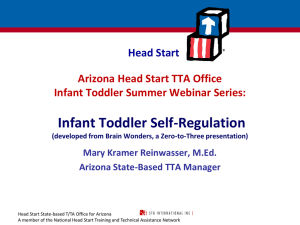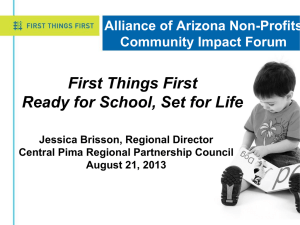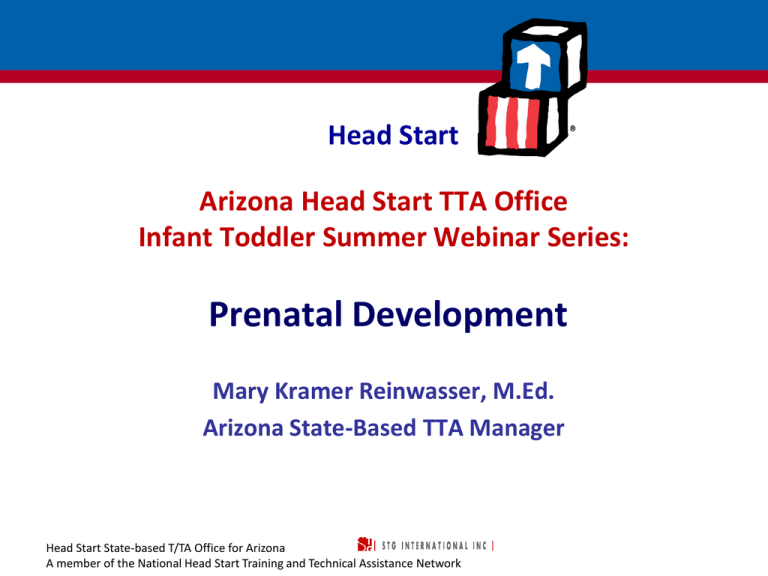
Head Start
Arizona Head Start TTA Office
Infant Toddler Summer Webinar Series:
Prenatal Development
Mary Kramer Reinwasser, M.Ed.
Arizona State-Based TTA Manager
Head Start State-based T/TA Office for Arizona
A member of the National Head Start Training and Technical Assistance Network
Agenda
• Define prenatal development
• Discuss development from fertilization to birth
• Identify possible congenital and maternal derived
abnormalities that may impact development
• Identify prenatal care recommendations
Head Start State-based T/TA Office for Arizona
A member of the National Head Start Training and Technical Assistance Network
2
Learning Outcomes
• Participants will be able to describe the general
development that occurs in each trimester.
• Participants will be able to identify the critical
windows of development that occurs during prenatal
development.
• Participants will be able to identify congenital and
maternal derived abnormalities that may impact
development.
• Participants will be aware of prenatal care
recommendations.
Head Start State-based T/TA Office for Arizona
A member of the National Head Start Training and Technical Assistance Network
3
What is prenatal development?
Prenatal development is the process in which
an embryo or fetus gestates during pregnancy,
from fertilization until birth.
– First Trimester- Month 1 thru 3
– Second Trimester- Month 4 thru 6
– Third Trimester- Month 7 thru 9
Stages:
– Germinal
– Embryonic
– Fetal
Head Start State-based T/TA Office for Arizona
A member of the National Head Start Training and Technical Assistance Network
4
Germinal Stage
Fertilization
Head Start State-based T/TA Office for Arizona
A member of the National Head Start Training and Technical Assistance Network
5
Zygote Development
Head Start State-based T/TA Office for Arizona
A member of the National Head Start Training and Technical Assistance Network
6
Embryonic Stage
Differentiation: clusters of
cells begin to take on
different functions. This is
called.
Gastulation:
– ectoderm (outer layer)
– mesoderm (middle
layer)
– endoderm (inner layer)
Head Start State-based T/TA Office for Arizona
A member of the National Head Start Training and Technical Assistance Network
7
Embryonic Milestones
Week 3: Beginning development of the brain, heart, blood cells, circulatory
system, spinal cord, and digestive system.
Week 4: Beginning development of bones, facial structures, and limbs; continuing
development of the heart (which begins to beat), brain, and nervous tissue.
Week 5: Beginning development of eyes, nose, kidneys, lungs; continuing
development of the heart (formation of valves), brain, nervous tissue, and
digestive tract.
Week 6: Beginning development of hands, feet, and digits; continuing
development of brain, heart, and circulation system.
Week 7: Beginning development of hair follicles, nipples, eyelids, and sex organs
(testes or ovaries); first formation of urine in the kidneys and first evidence of
brain waves.
Week 8: Facial features more distinct, internal organs well developed, the brain
can signal for muscles to move, heart development ends, external sex organs
begin to form.
Head Start State-based T/TA Office for Arizona
A member of the National Head Start Training and Technical Assistance Network
8
Fetal Stage
Month Three
Month Four
Head Start State-based T/TA Office for Arizona
A member of the National Head Start Training and Technical Assistance Network
Month Five
9
Fetal Stage (cont’d)
Month Six
Month Eight
Head Start State-based T/TA Office for Arizona
A member of the National Head Start Training and Technical Assistance Network
Month Seven
Month Nine
10
Critical Periods of Development
Body System
Especially Sensitive
Development up to …
CNS/Brain
4th to 8th weeks
Postnatal, through to
adulthood
Heart
5th to 9th weeks
12th week
Upper limbs
6th to 10th weeks
12th week
Eyes
6th to 10 weeks
Term
Lower limbs
6th to 10th weeks
12th week
Teeth
9th to 11th weeks
Term
Palate
9th to 11th weeks
16th week
External Genitalia
9th to 11th weeks
Term
Ears
6th to 11th weeks
13th week
Head Start State-based T/TA Office for Arizona
A member of the National Head Start Training and Technical Assistance Network
11
Prenatal Influences
Head Start State-based T/TA Office for Arizona
A member of the National Head Start Training and Technical Assistance Network
12
Nutrition
• Infant’s sole source of
nutrition
• Gain weight during
pregnancy, also increased
food intake
• What is eaten is also
important
– ex. folic acid and spina
bifida
• Inadequate nutrition:
premature birth, low birth
weight
Head Start State-based T/TA Office for Arizona
A member of the National Head Start Training and Technical Assistance Network
13
Stress
• Chronic stress of mother: lower birth weight,
physical and behavioral problems
• Greater harm earlier in pregnancy
• Prenatal stress:
– increase in stress hormones of mother that
reduce oxygen to fetus
– weaken mother’s immune system
– some protective functions to lessen effects of
stress
Head Start State-based T/TA Office for Arizona
A member of the National Head Start Training and Technical Assistance Network
14
Maternal Age
• Over 35
– Gestational diabetes
– High blood pressure
– Placenta problems
– Prematurity
– Stillbirth
• Adolescents
– Low birth weight
– Poorer nutrition
– Less prenatal care
Head Start State-based T/TA Office for Arizona
A member of the National Head Start Training and Technical Assistance Network
15
Drug Use and Abuse
General drugs:
– alcohol, aspirin, caffeine, cocaine & heroin,
marijuana, nicotine
Ex.: Fetal Alcohol Syndrome (FAS)
– grow more slowly, have heart problems, and
misshapen faces
– leading cause of mental retardation
Head Start State-based T/TA Office for Arizona
A member of the National Head Start Training and Technical Assistance Network
16
Disease and Infection
• General diseases:
– AIDS, cytomeglovirus, rubella, syphilis
• Some diseases can pass through placenta,
others cause damage at birth
Head Start State-based T/TA Office for Arizona
A member of the National Head Start Training and Technical Assistance Network
17
Environmental Hazards
• Toxins in food, fluids,
and air (ex. lead,
mercury, PCBs, X-rays)
• Small amounts that do
not affect adults can
still affect the
developing fetus
• Unaware of presence in
environment
Head Start State-based T/TA Office for Arizona
A member of the National Head Start Training and Technical Assistance Network
18
Congenital Abnormalities
Abnormalities:
– mutation in or damage to the genetic material of
cells
– major chromosomal abnormality
Causes:
– inherited from one or both parents
– error in prenatal development
Long-term prognosis
Head Start State-based T/TA Office for Arizona
A member of the National Head Start Training and Technical Assistance Network
19
Prenatal Care
• Folic Acid and
Prenatal/Preconception
Vitamins
• Proper Immunizations for
the Mother
• Healthy Behaviors
Head Start State-based T/TA Office for Arizona
A member of the National Head Start Training and Technical Assistance Network
20
Summary
• Critical periods of development occur throughout
prenatal development.
• Healthy behaviors before, during, and after
pregnancy can positively impact development
• Understanding prenatal development and the
importance of prenatal care is important
• Resources:
– American Academy of Pediatrics
– National Institute of Child and Human Development
Head Start State-based T/TA Office for Arizona
A member of the National Head Start Training and Technical Assistance Network
21
The Arizona Head Start Training and Technical Assistance Office
and STG International thank you for joining our webinar today!
Please continue to join the 2010 Summer Webinar Series
occurring every Tuesday and Thursday during the months of
June and July at 3:00 Pacific Daylight Time.
Please contact Mary Kramer Reinwasser at
mary.reinwasser@stginternational.com for more information.
Head Start State-based T/TA Office for Arizona
A member of the National Head Start Training and Technical Assistance Network
22


